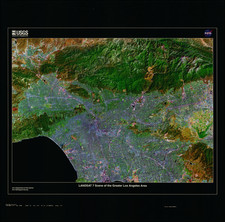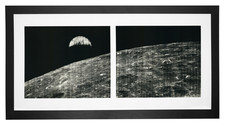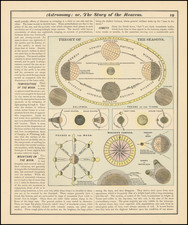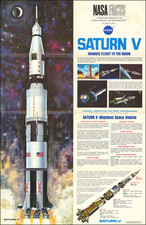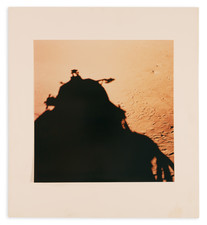Official NASA-Boeing Documentary Photograph of the Apollo 15 Lunar Rover Vehicle.
Large format glossy color photograph of the Lunar Rover Vehicle, presumably at the Boeing assembly facility in Huntsville, Alabama.
This large photograph of the LRV is substantially bigger than other similar original photographs of the vehicle. Many of the components of the LRV are visible in fairly good detail, including the unusual low-g mesh wheels.
Provenance
From the collection of a veteran of Boeing's Public Relations and Advertising Department who joined the company in 1961.
The Apollo 15 mission was the fourth voyage to the moon and the first "J mission," missions that spent slightly longer on the moon. This mission represented a shift towards scientific observations, though it was also marred in public opinion due to several scandals and incidents.
The mission was crewed by David Scott, James Irwin, and Alfred Worden. These three were all accomplished pilots, and they constituted the first crew to land on the moon who were all interested in scientific exploration. Stuart Roosa had attempted to make extensive scientific observations during Apollo 14, but the lack of interest from Alan Shepherd hampered his effort. Apollo 13 had similar objectives to Apollo 15 but did not land. The J mission structure was also better suited for longer periods of observations, and all of these factors contributed to one of the most successful Apollo missions.
As the three crewmembers had trained as the backup crew for Apollo 12, they were well prepared to fly and so could spend more time preparing their scientific experiments, in particular those that related to the subject of geology. Caltech geologist Lee Silver was in charge of teaching useful skills to Scott and Irwin, who would land, while lead Apollo Program geologist Farouk El-Baz taught Worden, who would remain in orbit. The three went on increasingly complex geological field trips where they made joint ground and areal observations, which would be relayed through CAPCOM to geologists unfamiliar with the area. The three went on twenty monthly field trips prior to launching.
The mission landed at Hadley Rille located on the east side of the Mare Imbrium. The area is a deep channel bounded by the five-kilometer high Montes Apenninus. This area was particularly difficult to land at which coupled with the new thruster systems to make for a hard and off-kilter landing. Once landed, the crew made a series of three EVA over a sixty-seven hour period on the mon's surface.
The many different observations made during this voyage would contribute to scientific progress in a lot of different ways. The field observations made helped to constrain the relative ages of various structures in the area, as well as determine more about how they came about. Of particular interest were the many breccias and flow deposits discovered, apparently from the Apennine Mountains. These provided constraints on the orogenic history of the structure. In addition to field observations, the astronauts brought various instruments to help them better understand the geology of the area and were even able to extract a core sample, albeit with much difficulty.
One of the samples collected was named the "genesis rock," which had an evolved composition and was originally believed to be part of the moon's primordial crust, although later dating showed it was only 4.1 billion years old, while the moon would have formed around 4.51 billion years ago. The sample still has some interest as the samarium-neodymium age, which records extractive processes that the source material of the rock went through, suggests an age of 4.46 billion years for the appearance of evolved lunar rocks.
While the mission completed its many scientific objectives, two main incidents tarnished the crew in the eyes of NASA. The first was the issue regarding a "Fallen Astronaut" memorial, in which the crew left a plaque with the names of fourteen American and Soviet pilots who died due to space exploration, alongside a small statuette. The artist who created this work later tried to sell some copies of his statue, claiming that he had been given permission to do so even though NASA regulations prevented the use of the space program for private economic gain. The second issue involved the astronauts taking a collection of four hundred unauthorized postal covers into space, one hundred of which were later sold in West Germany at a large profit. While this was common practice in earlier missions and not technically against the rules, the newspaper discovery of this incident led to House and Senate hearings. The three astronauts would never fly again.











